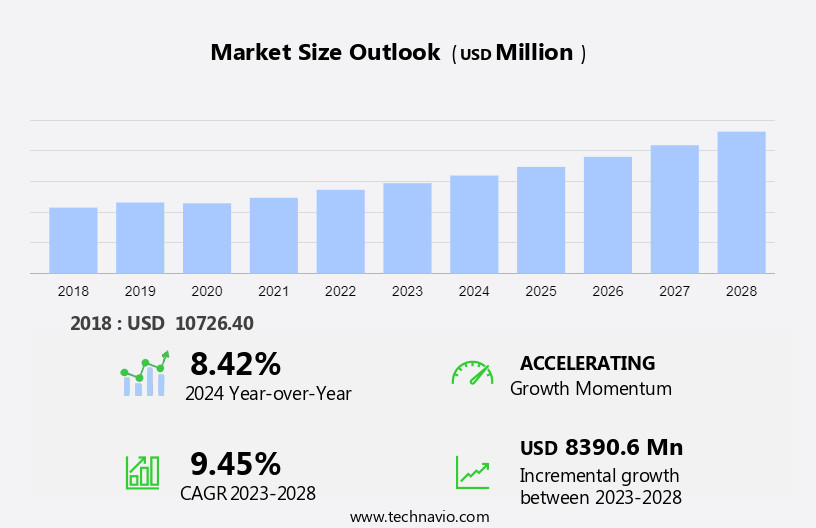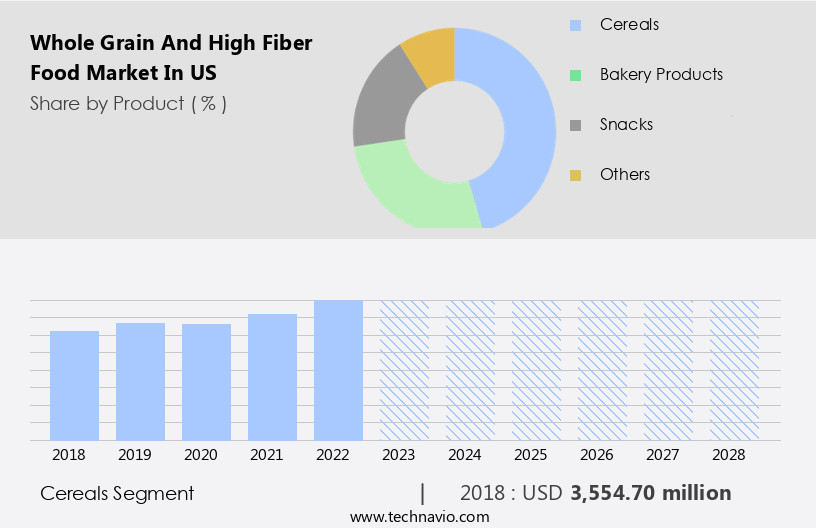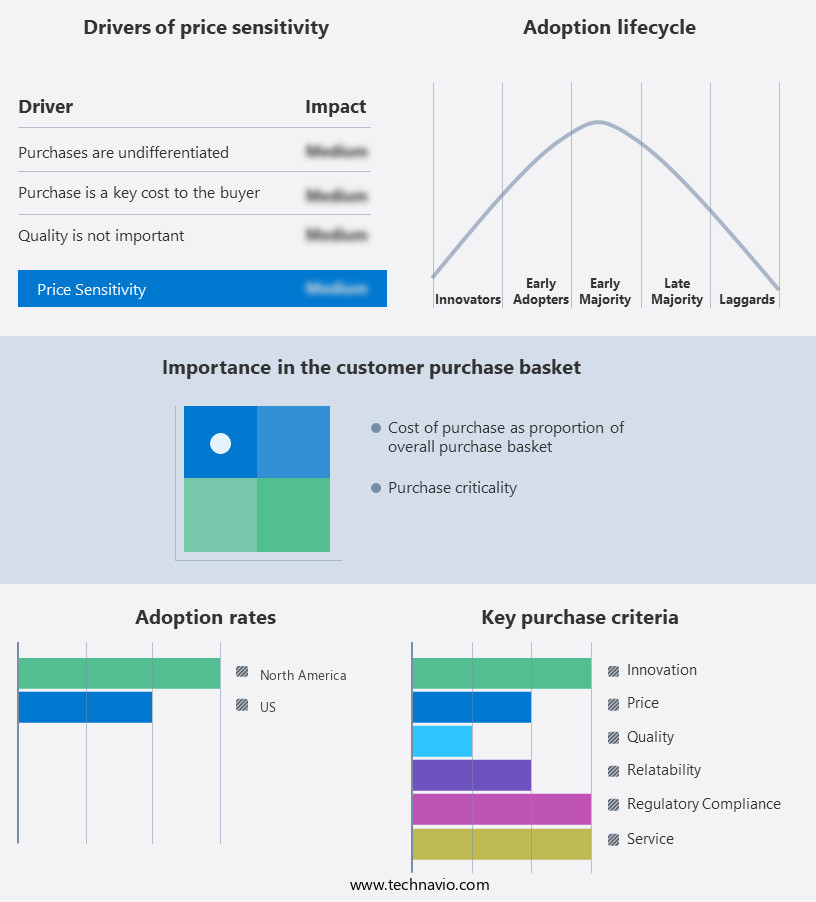US Whole Grain And High Fiber Food Market Size 2024-2028
The US whole grain and high fiber food market size is forecast to increase by USD 8.39 billion at a CAGR of 9.45% between 2023 and 2028.
- The whole grain and high fiber food market is experiencing significant growth, driven by the increasing health consciousness among consumers. The health benefits of whole grains and high fiber foods, such as reducing the risk of chronic diseases and promoting digestive health, have made them a popular choice for health-conscious consumers. In the US, new product developments in whole grain and high fiber food continue to emerge, with companies introducing innovative offerings to cater to evolving consumer preferences.
- Soluble fibers, such as oats and barley, help lower cholesterol levels, while insoluble fibers, such as wheat and maize, promote digestive health. However, fluctuations in whole grain prices pose a challenge to market growth. Despite this, the market is expected to continue expanding, fueled by the growing demand for nutritious and convenient food options. The report provides an in-depth analysis of these trends and challenges, offering valuable insights for stakeholders In the whole grain and high fiber food industry.
What will be the size of the US Whole Grain And High Fiber Food Market during the forecast period?

Request Free Sample
- The Whole Grain and High Fiber Food Market is witnessing significant growth due to the increasing health consciousness among consumers. Whole grains and high fiber foods are essential nutrients for maintaining a healthy digestive system and reducing the risk of obesity and other health issues. Foods like bakery items, breakfast cereals, savory snacks, pasta, wheat, multi-grain, maize, brown rice, quinoa, barley, oats, and others are popular choices for consumers seeking to incorporate more whole grains and high fiber into their diets. Public awareness campaigns promoting the benefits of a healthy diet and lifestyle have influenced consumer behavior, leading to a rise in demand for whole grain and high fiber foods.
- Demographic factors such as an aging population and a growing preference for natural and organic foods are also driving market growth. The market for High Fiber Foods includes Soluble Foods and Insoluble Foods. The market is further segmented into e-commerce and independent retail outlets. A low carbohydrate diet or a high protein diet does not necessarily mean avoiding whole grains and high fiber foods. In fact, incorporating these foods into such diets can provide additional health benefits. Overall, the Whole Grain and High Fiber Food Market is expected to continue growing as consumers prioritize their health and wellness.
How is this market segmented and which is the largest segment?
The market research report provides comprehensive data (region-wise segment analysis), with forecasts and estimates in "USD billion" for the period 2024-2028, as well as historical data from 2018-2022 for the following segments.
- Product
- Cereals
- Bakery products
- Snacks
- Others
- Distribution Channel
- Type
- Geography
By Product Insights
- The cereals segment is estimated to witness significant growth during the forecast period. Whole grains and high fiber foods have gained significant attention In the health and fitness industry due to their numerous nutritional benefits. These foods, rich in dietary fiber, are essential for maintaining digestive health and supporting weight loss efforts. Obesity rates continue to rise, making health consciousness a top priority for many consumers. Whole grains, including wheat, maize, brown rice, quinoa, barley, and oats, are fiber-rich and offer a range of health benefits. Bakery items, such as whole grain bread and rye, are popular choices for those seeking fiber-rich alternatives to traditional refined grains. Breakfast cereals fortified with whole grains and high in fiber are also favored by those following healthier eating patterns.
- Snack bars and protein bars, often fortified with functional additives like prebiotic compounds, provide convenient options for those on-the-go. Savory snacks, such as popcorn and whole grain crackers, offer fiber-rich alternatives to processed, high-calorie snacks. Pasta made from whole grains provides a fiber-rich, protein-packed alternative to traditional pasta. Flavor categories, such as savory and sweet, cater to diverse taste preferences while maintaining nutritional integrity. Gluten-free whole grain options, including rice and corn-based products, are increasingly popular among those with dietary restrictions. Nutritional attributes, such as high protein and low sugar, are also important considerations for consumers seeking healthy food products. Overall, the demand for whole grain and high fiber foods is driven by a growing awareness of the importance of these nutrients for overall health and wellness.

Get a glance at the market share of various segments Request Free Sample
- The cereals segment was valued at USD 3.55 billion in 2018 and showed a gradual increase during the forecast period.
Market Dynamics
Our researchers analyzed the data with 2023 as the base year, along with the key drivers, trends, and challenges. A holistic analysis of drivers will help companies refine their marketing strategies to gain a competitive advantage.
What are the key market drivers leading to the rise in adoption of US Whole Grain And High Fiber Food Market?
- Health benefits of whole grain and high fiber foods is the key driver of the market. Whole grain and high fiber foods have gained significant attention In the health and fitness community due to their numerous nutritional benefits. With obesity rates on the rise in developed countries, such as the United States, there is a growing demand for fiber-rich, nutrient-dense foods. Urbanization and changing eating patterns have led to an increase In the prevalence of diet-related diseases, including obesity and heart disease. In response, consumers are becoming more health-conscious and are seeking out foods that offer optimal nutritional attributes. Whole grains, including wheat, maize, brown rice, quinoa, barley, oats, and rye, are a rich source of dietary fiber and essential nutrients.
- These grains are used in various food categories, such as bakery items, breakfast cereals, snack bars, savory snacks, pasta, and more. Flavor categories and gluten-free options are also available to cater to diverse consumer preferences. Functional additives, such as prebiotic compounds, further enhance the health benefits of these foods. Protein bars and weight loss products are also popular choices for those seeking fiber-rich, protein-packed options for weight management. The health benefits of whole grains and high fiber foods extend to improved digestibility and traditional food options. As health awareness continues to grow, it is expected that the market for healthy food products will continue to expand, providing consumers with a wide range of options to meet their nutritional needs.
What are the market trends shaping the US Whole Grain And High Fiber Food Market?
- New product developments in whole grain and high fiber food in US is the upcoming trend In the market. The whole grain and high fiber food market In the US is witnessing continuous innovation and growth, with a focus on the development of new products. Whole grains, such as quinoa and amaranth, are gaining popularity due to their nutritional attributes. Quinoa, a gluten-free grain, is widely used as a breakfast item, while amaranth, another gluten-free grain, is known for its high fiber content and ability to absorb flavors well, making it an excellent addition to savory snacks, stews, and soups. These grains offer various health benefits, including being rich in dietary fiber, protein, and essential amino acids. The market is in its initial growth phase, with an increasing number of consumers prioritizing health and fitness, and seeking fiber-rich, whole grain alternatives to traditional foods like pasta, wheat, multi-grain, maize, brown rice, quinoa, barley, and oats.
- The trend towards health consciousness and dietary awareness is driving the demand for fiber-rich, protein bars, and weight loss products. The market is expected to expand further with the introduction of functional additives and prebiotic compounds. The obesity rates In the US continue to rise, making the need for healthy food products more pressing. The bakery industry is also adapting to this trend, offering whole grain and high fiber options, including bread and baked goods. Overall, the whole grain and high fiber food market In the US is poised for significant growth, as consumers increasingly prioritize health and wellness In their eating patterns.
What challenges does US Whole Grain And High Fiber Food Market face during the growth?
- Fluctuations in whole grain prices is a key challenge affecting the market growth. Whole grain and high fiber foods have gained significant attention In the health and fitness industry due to their numerous nutritional benefits. These foods, which include bakery items, breakfast cereals, snack bars, pasta, and various grains like wheat, multi-grain, maize, brown rice, quinoa, barley, and oats, are rich in dietary fiber, protein, and essential vitamins and minerals. However, the high price of these foods can be a barrier for consumers, particularly those who are diet-conscious and health-aware, or those trying to manage obesity or weight loss. Players In the food industry are addressing this challenge by entering into advance purchase contracts with manufacturers and suppliers to mitigate price fluctuations.
- Natural disasters and adverse weather conditions, such as floods, earthquakes, droughts, frost, and pestilence, can impact the availability and price of raw materials and commodities used In the production of whole grain and high-fiber foods. Despite these challenges, the demand for these foods remains strong due to their health benefits and consumers' increasing health consciousness. Flavor categories, functional additives, prebiotic compounds, and gluten-free options are also driving innovation in this market. Savory snacks, protein bars, and other fiber-rich foods are popular choices for those following eating patterns focused on healthy food products. Obesity rates continue to rise globally, making the importance of whole grains and high-fiber foods more critical in maintaining a balanced and healthy diet.
Exclusive US Whole Grain And High Fiber Food Market Customer Landscape
The market forecasting report includes the adoption lifecycle of the market, market growth and forecasting, covering from the innovator's stage to the laggard's stage. It focuses on adoption rates in different regions based on penetration. Furthermore, the report also includes key purchase criteria and drivers of price sensitivity to help companies evaluate and develop their market growth analysis strategies.

Customer Landscape
Key Companies & Market Insights
Companies are implementing various strategies, such as strategic alliances, market forecast partnerships, mergers and acquisitions, geographical expansion, and product/service launches, to enhance their presence In the market.
The market research and growth report includes detailed analyses of the competitive landscape of the market and information about key companies, including:
- Ardent Mills LLC
- B and G Foods Inc.
- Bobs Red Mill Natural Foods Inc.
- Campbell Soup Co.
- Cargill Inc.
- Conagra Brands Inc.
- CreaFill Fibers Corp.
- Flowers Foods Inc.
- Food For Life Baking Co. Inc.
- General Mills Inc.
- Glanbia plc
- Grain Millers Inc.
- Hodgson Mill
- Kellogg Co.
- McKee Foods
- MGP Ingredients Inc.
- Mondelez International Inc.
- Natures Path Foods
- Nestle SA
- PepsiCo Inc.
Qualitative and quantitative analysis of companies has been conducted to help clients understand the wider business environment as well as the strengths and weaknesses of key market players. Data is qualitatively analyzed to categorize companies as pure play, category-focused, industry-focused, and diversified; it is quantitatively analyzed to categorize companies as dominant, leading, strong, tentative, and weak.
Research Analyst Overview
Whole grains and high fiber foods have gained significant attention In the health and fitness world due to their numerous health benefits. These nutrient-dense foods, including whole grains such as wheat, maize, brown rice, quinoa, barley, oats, and rye, are rich in dietary fiber, essential nutrients, and antioxidants. The demand for whole grains and high fiber foods is driven by demographic factors, health consciousness, and dietary trends. Obesity rates continue to rise, making people more health-conscious and diet-conscious. Whole grains and high fiber foods are known to aid in weight loss and improve digestibility. Bakery items, breakfast cereals, snack bars, savory snacks, pasta, and protein bars are some popular food categories that offer whole grains and high fiber.
Flavor categories and nutritional attributes also play a crucial role In the marketing of these foods. Gluten-free foods and prebiotic compounds are some of the functional additives that are increasingly being used in whole grain and high fiber products. Health benefits, such as reducing the risk of chronic diseases, improving heart health, and enhancing digestive health, further focus on the importance of these foods in our diet. Traditional foods, such as rye, are making a comeback due to their health benefits and unique flavors. The market for whole grains and high fiber foods is expected to grow as more people prioritize their health and seek out fiber-rich, nutritious, and delicious food options.
|
Market Scope
|
|
Report Coverage
|
Details
|
|
Page number
|
151
|
|
Base year
|
2023
|
|
Historic period
|
2018-2022 |
|
Forecast period
|
2024-2028
|
|
Growth momentum & CAGR
|
Accelerate at a CAGR of 9.45%
|
|
Market growth 2024-2028
|
USD 8.39 billion
|
|
Market structure
|
Fragmented
|
|
YoY growth 2023-2024(%)
|
8.42
|
|
Competitive landscape
|
Leading Companies, Market Positioning of Companies, Competitive Strategies, and Industry Risks
|
Request Free Sample
What are the Key Data Covered in this Market Research Report?
- CAGR of the market during the forecast period
- Detailed information on factors that will drive the market growth and forecasting between 2024 and 2028
- Precise estimation of the size of the market and its contribution of the market in focus to the parent market
- Accurate predictions about upcoming market growth and trends and changes in consumer behaviour
- Growth of the market across US
- Thorough analysis of the market's competitive landscape and detailed information about companies
- Comprehensive analysis of factors that will challenge the growth of market companies
We can help! Our analysts can customize this market research report to meet your requirements Get in touch
Research Framework
Technavio presents a detailed picture of the market by way of study, synthesis, and summation of data from multiple sources. The analysts have presented the various facets of the market with a particular focus on identifying the key industry influencers. The data thus presented is comprehensive, reliable, and the result of extensive research, both primary and secondary.
 INFORMATION SOURCES
INFORMATION SOURCES
Primary sources
- Manufacturers and suppliers
- Channel partners
- Industry experts
- Strategic decision makers
Secondary sources
- Industry journals and periodicals
- Government data
- Financial reports of key industry players
- Historical data
- Press releases

 DATA ANALYSIS
DATA ANALYSIS
Data Synthesis
- Collation of data
- Estimation of key figures
- Analysis of derived insights
Data Validation
- Triangulation with data models
- Reference against proprietary databases
- Corroboration with industry experts

 REPORT WRITING
REPORT WRITING
Qualitative
- Market drivers
- Market challenges
- Market trends
- Five forces analysis
Quantitative
- Market size and forecast
- Market segmentation
- Geographical insights
- Competitive landscape








![]() Get the report (PDF) sent to your email within minutes.
Get the report (PDF) sent to your email within minutes.
Complimentary full Excel data with your report purchase.